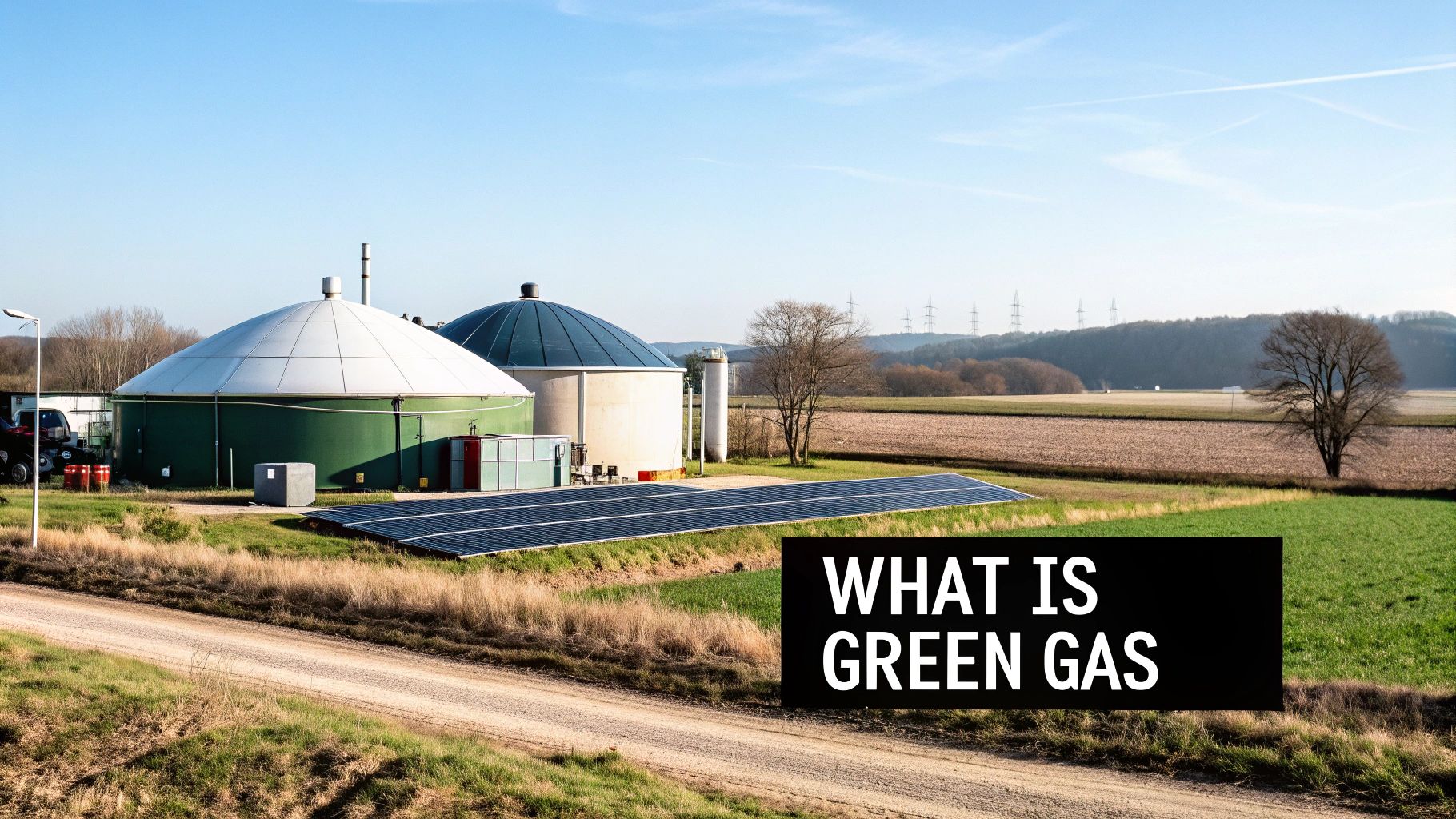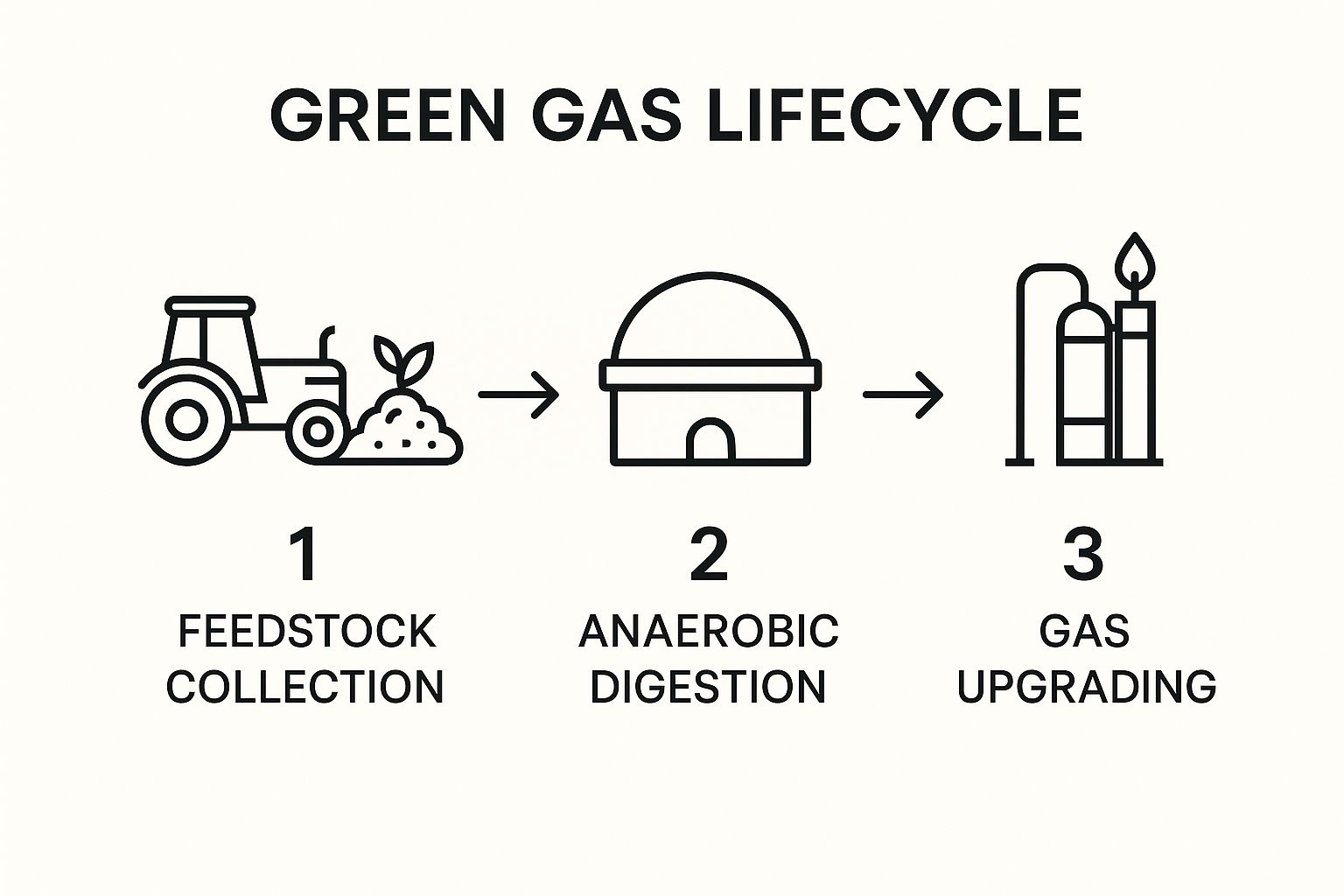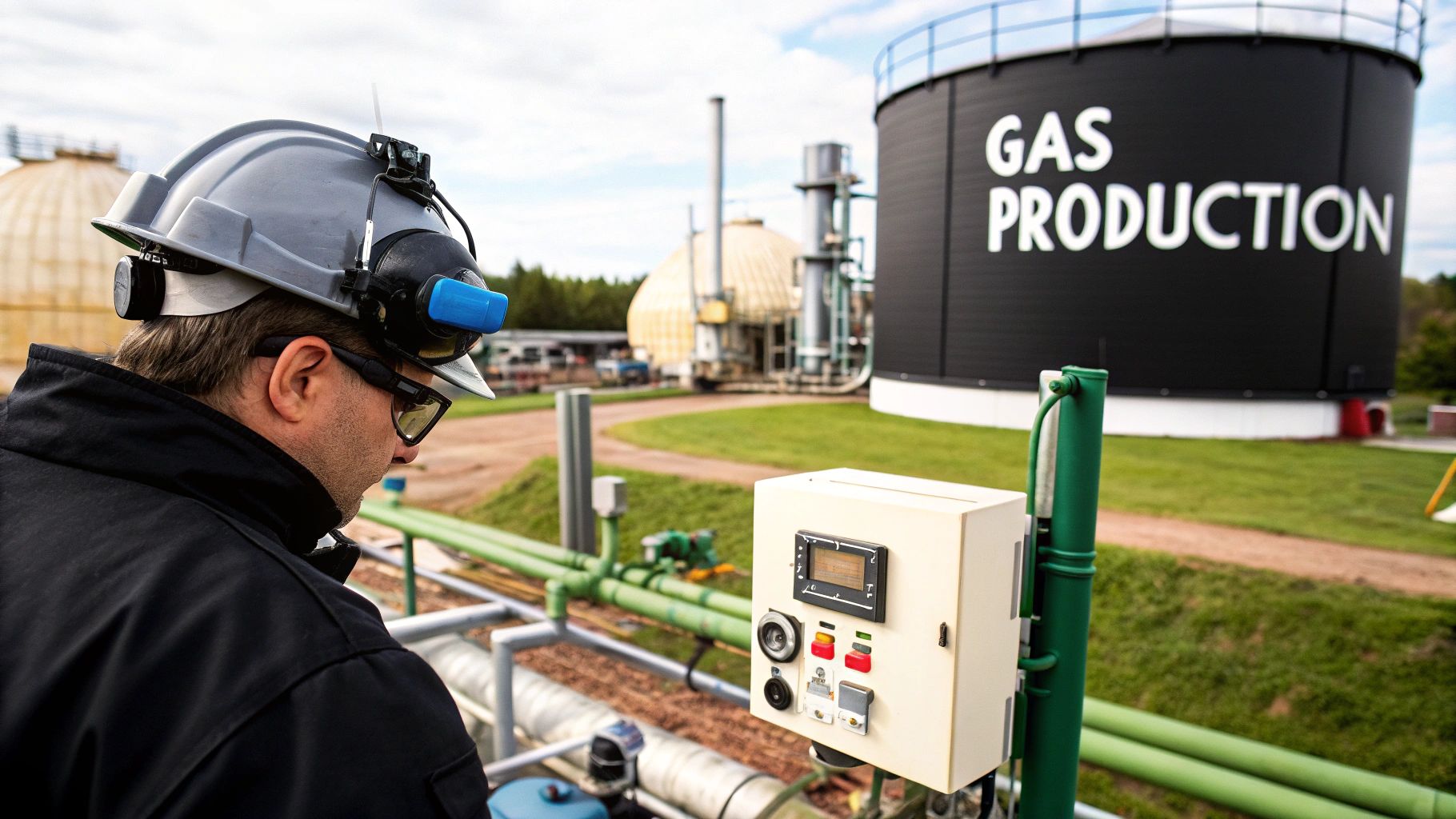When you hear the term green gas, think of it as a clean, renewable version of the natural gas many of us already use. It's an umbrella term for fuels designed to do the same job as conventional natural gas but without the fossil fuel footprint.
The two main players in the green gas world are biomethane and green hydrogen. Both offer a sustainable way to power everything from our homes and businesses to our vehicles.
What Is Green Gas?

At its heart, green gas is a carbon-neutral fuel that’s chemically almost identical to the natural gas pulled from the ground. The magic is in how it’s made. Instead of drilling for ancient fossil fuels, we create it by upcycling organic waste—things like agricultural manure, food scraps, and even sewage.
Normally, this waste would just decompose, releasing potent methane gas directly into the atmosphere. But with green gas production, we intercept that process. We capture the emissions and turn a major pollution problem into a powerful energy solution.
The best part? This fuel is a perfect stand-in for conventional natural gas. It can be injected directly into the existing gas grid without any expensive or disruptive infrastructure changes.
The Two Main Types of Green Gas
To really get a handle on green gas, it helps to understand its two distinct forms. Each one plays a critical, yet different, role in shifting our energy system toward a cleaner future.
- Biomethane: This is produced by capturing biogas from decomposing organic matter. This raw gas is then cleaned up and purified, removing impurities until what's left is essentially pure methane—the same molecule as conventional natural gas.
- Green Hydrogen: This type is created through a process called electrolysis. It uses renewable electricity from sources like wind or solar to split water (H₂O) into its basic elements: hydrogen and oxygen. The resulting hydrogen is a completely clean-burning fuel.
Green gas represents a fundamental shift from a linear "take-make-waste" energy model to a circular one. It closes the loop by turning waste back into a resource, reducing emissions and strengthening our energy independence.
This isn't just a niche idea; it's a rapidly growing market. Valued at roughly USD 1.86 billion in 2025, the green gas sector is on track to hit about USD 2.87 billion by 2032. For now, biomethane is the dominant force, showing just how vital it is for our immediate energy needs. For a deeper dive into market trends, you can explore the latest insights about the green gas market from Coherent Market Insights.
Green Gas vs Natural Gas at a Glance
To make things even clearer, here’s a quick comparison showing the core differences between renewable green gas and its fossil-based counterpart.
| Feature | Green Gas | Conventional Natural Gas |
|---|---|---|
| Source | Organic waste, renewable electricity | Fossil fuel deposits |
| Carbon Impact | Carbon-neutral or carbon-negative | Emits new CO2 into the atmosphere |
| Sustainability | Renewable and circular | Finite and non-renewable |
| Production | Anaerobic digestion, electrolysis | Drilling and fracking |
While they serve the same purpose in our pipes and appliances, their origins and environmental impacts couldn't be more different. Green gas offers a path forward that aligns with our climate goals.
From Waste to Fuel: How Green Gas Is Made
So, how exactly do we turn a pile of farm waste or leftover food scraps into a clean-burning fuel? It might sound like modern-day alchemy, but the process is surprisingly natural. There are two main ways we can create this powerful, renewable resource, and both offer a smart alternative to traditional fossil fuels.
One path relies on a process called anaerobic digestion. The easiest way to think about it is like a giant, mechanical stomach. We take organic materials—anything from farm manure and leftover crops to food waste and sewage—and put them into a large, sealed tank called a digester. Inside this oxygen-free environment, tiny microorganisms get to work, breaking down the waste.
As these microbes munch away, they release a raw gas mixture known as biogas. This is the first step in our journey from waste to energy.
The Journey from Biogas to Biomethane
Now, this raw biogas is a great start, but it's not quite ready to be pumped into our homes and businesses. It’s typically made up of about 60% methane and 40% carbon dioxide (CO₂), along with a few other trace gases. To be a true stand-in for conventional natural gas, it needs a bit of a clean-up.
This is where a process called upgrading comes in. The biogas is filtered to scrub out the CO₂ and other impurities. What’s left behind is almost pure methane, a fuel we call biomethane. The beauty of biomethane is that it's chemically identical to fossil-based natural gas, meaning we can use it in our existing infrastructure without any modifications.
This simple infographic shows the whole process from start to finish.

As you can see, it’s a truly circular system. We take waste that would otherwise rot and release harmful emissions, capture it, and turn it into a valuable source of clean energy.
Making Green Hydrogen with Electrolysis
The other major way to produce green gas is by creating green hydrogen. This method is a bit different because it doesn't use organic waste. Instead, it uses renewable electricity to make a fuel that’s completely emission-free from start to finish.
The science behind it is called electrolysis. It works by passing an electrical current through water (H₂O), which splits the water molecules into their two core components: hydrogen and oxygen. The crucial part is where that electricity comes from. To be considered truly "green," the power must be generated by renewable sources, like solar panels or wind turbines.
When you use renewable energy for electrolysis, you create a fuel with zero carbon footprint. The only byproduct of the entire cycle—from production all the way to its use—is pure water. This makes green hydrogen one of the cleanest fuels imaginable.
Once we've produced this green hydrogen, it’s incredibly versatile. We can store it to generate electricity later, use it to power vehicles equipped with fuel cells, or even blend it in small amounts into the existing natural gas grid. It’s a fantastic way to bottle up excess energy from sunny or windy days, giving us a reliable power source for when conditions change.
The Benefits of Adopting Green Gas

Switching to green gas isn't just about swapping one fuel for another. It’s about creating a positive ripple effect that benefits the environment, strengthens local economies, and even improves national energy security. The most obvious win, of course, is for our climate.
By capturing emissions from places like landfills and farms, the production of green gas stops powerful greenhouse gases from ever reaching the atmosphere. It literally takes an environmental problem and turns it into a clean, valuable energy source.
A Powerful Environmental Impact
The real environmental hero story of green gas is its ability to tackle methane. Methane is a super-potent greenhouse gas, with a warming power over 25 times greater than carbon dioxide over a 100-year timeline. When organic waste breaks down in a landfill or a manure pit, it just pumps this destructive gas straight into the air.
Green gas production puts a stop to that. Instead of letting methane escape, the process captures it and refines it into biomethane. This simple intervention delivers a one-two punch against climate change:
- It stops harmful emissions: Capturing methane at the source prevents it from ever contributing to global warming.
- It displaces fossil fuels: The green gas created is used in place of conventional natural gas, which means we avoid the emissions that come from drilling and extraction.
Methane is a huge piece of the climate puzzle, with global emissions hitting around 31.94 million tonnes (CH4) in April 2025. By turning this problem into a solution, green gas offers a direct and powerful way to lower our climate footprint. You can dig into the specifics of the most recent global emissions data from Climate TRACE to see the scale of the issue.
By capturing methane at its source, green gas doesn't just offer a cleaner fuel—it actively removes a significant amount of warming potential from the atmosphere, making it a carbon-negative solution in many cases.
Boosting Local Economies and Energy Security
Beyond the clear environmental wins, green gas is also a fantastic tool for economic growth. It builds a circular economy by creating real value from things we used to just throw away. A farmer can suddenly earn extra income from agricultural waste, and a local government can turn its landfill gas into a profitable asset for the community.
This whole process creates jobs, especially in rural areas where farming and waste management are central to the economy. It encourages local investment in new facilities and technology, building stronger, more diverse economies from the inside out.
And because green gas is made right here at home, it makes the entire country more energy-secure. When we make our own fuel from our own waste, we don’t have to rely as much on unpredictable and often volatile international fossil fuel markets. This helps protect our economy from global conflicts and wild price swings, giving homes and businesses a much more stable and reliable energy supply.
Green Gas in Action: Real-World Uses
The potential of green gas isn't some far-off concept; it's already at work, blending right into the energy systems we rely on every day. This isn't about reinventing the wheel. It's about using a smarter, cleaner fuel in the infrastructure we already have.
From heating homes to fueling the trucks that move our goods, green gas is proving its value in incredibly practical ways.
One of its most powerful applications is also the simplest: injecting biomethane straight into the existing natural gas grid. Since it's chemically the same as conventional gas, it mixes in without anyone noticing a difference. That means the gas heating your home or cooking your dinner can become progressively greener without changing a single appliance. It’s a quiet but significant step toward decarbonization.
Fueling a Cleaner Transportation Sector
When it comes to transportation, green gas is a game-changer, especially for heavy-duty vehicles that have historically relied on diesel. By compressing or liquefying it into bio-CNG (Compressed Natural Gas) or bio-LNG (Liquefied Natural Gas), we get a powerful, clean-burning fuel that's ready for the road.
This is making a real difference for:
- City Buses: Public transit authorities are swapping out diesel buses for quieter, cleaner bio-CNG models, which immediately improves urban air quality.
- Long-Haul Trucks: Logistics companies are adopting bio-LNG to fuel their fleets, slashing the carbon footprint of cross-country shipping.
- Waste Management Vehicles: In a perfect "closed-loop" scenario, garbage trucks can actually run on fuel produced from the organic waste they collect.
This shift does more than just lower emissions; it gives cities and companies a proven way to hit their sustainability targets today, not years from now.
By powering essential vehicles with a fuel derived from waste, we turn a logistical necessity into an environmental victory. Each mile driven on green gas helps close the loop between consumption and renewal.
Power Generation and Industrial Applications
Beyond the grid and the highway, green gas is also a reliable source for generating electricity. Wind and solar are fantastic, but they're intermittent—they only work when the sun is out or the wind is blowing. A power plant fueled by biomethane, however, can generate electricity 24/7.
This makes it the perfect partner for renewables, providing a stable energy supply that can fill the gaps and keep the lights on. Many industries also depend on this kind of steady power for high-heat processes, like making glass or steel.
Ensuring Energy Continuity with Virtual Pipelines
What happens when you need gas power but you're nowhere near a pipeline? Maybe it's a new construction site, a remote industrial facility, or a pipeline that's temporarily shut down for maintenance.
This is where a virtual pipeline comes in. Instead of a physical pipe, energy is delivered on wheels. Companies like Blue Gas Express specialize in providing these temporary CNG and LNG services. By loading their mobile units with renewable natural gas, they create an on-demand energy bridge.
This ensures a continuous, cleaner fuel supply for critical tasks—from commissioning new equipment to preventing pipes from freezing in the winter—all without having to fall back on dirtier options like diesel.
Overcoming Challenges to Green Gas Adoption

While the potential of green gas is massive, the road to making it a mainstream energy source has its share of bumps. We're talking about shifting an entire energy system, and that means taking on some serious economic and infrastructural challenges that have long favored traditional fossil fuels.
Let's start with the elephant in the room: cost. Right now, producing green gas often costs more than pulling conventional natural gas out of the ground. That’s because the fossil fuel industry has had decades to perfect its methods and build out infrastructure, not to mention the government subsidies it often receives. Without policies like tax credits or carbon pricing to level the playing field, green gas struggles to compete on price alone.
Scaling Up Production and Infrastructure
Then there's the logistics. To make biomethane on a large scale, you need a steady, reliable stream of organic waste. That requires building sophisticated collection systems for everything from farm manure to food scraps, which means a big upfront investment in trucks, pipelines, and processing plants.
This challenge gets even tougher when you look at the bigger picture. Despite climate goals, many governments are still doubling down on fossil fuels. In fact, projected gas production for 2030 is about 92% higher than what’s needed to keep global warming to 1.5°C. Every new fossil fuel project locks in carbon-heavy infrastructure for years to come, making it that much harder for cleaner alternatives like green gas to gain a foothold. You can dig into the numbers yourself in the 2025 Production Gap Report.
The biggest barrier to green gas adoption isn't just technology—it's overcoming the inertia of an energy system built around fossil fuels. Real progress requires a clear policy shift that levels the playing field for renewable solutions.
The Path Forward Is Promising
But it's not all doom and gloom. Despite these hurdles, the future for green gas looks incredibly bright. As the technology matures and production becomes more efficient, costs are coming down. This trend is getting a major boost from the global push for net-zero emissions, which is creating real market demand for renewable fuels.
Innovators are also finding new and better ways to integrate green gas into our energy grid. When you combine that progress with growing investment from both the public and private sectors, you can see a clear path for green gas to evolve from a niche player into a mainstream energy source. The key is to keep up the momentum and create an environment where these clean technologies can truly flourish.
Common Questions About Green Gas
As more people talk about renewable energy, it’s completely normal to have questions. Green gas is a fantastic and practical alternative to old-school fossil fuels, but some of the ideas behind it can feel a little technical at first.
To help make things clearer, we've put together answers to some of the questions we hear most often. This should give you a solid handle on what green gas is, how it really works, and where it fits into our energy future.
Is Green Gas the Same as Natural Gas?
This is easily the most common question, and the answer is a bit of a "yes and no." Chemically speaking, biomethane (a primary form of green gas) is practically a twin to conventional natural gas. They're both made almost entirely of methane (CH₄).
This is a massive advantage. It means we can pump biomethane right into the existing gas grid we've used for decades. Your furnace, water heater, or stove can't tell the difference between a methane molecule that came from a fossil fuel deposit and one that came from a biodigester—they just work.
But here’s the crucial difference: their origin stories are worlds apart. Natural gas is a finite fossil fuel we pull from deep underground, releasing carbon that's been trapped for millions of years. Green gas, on the other hand, comes from renewable organic stuff like farm waste. It’s part of a living, circular carbon cycle, which makes it a much cleaner and more sustainable choice.
Can My Home Actually Run on Green Gas?
Absolutely, though it’s not quite as simple as a special "green gas pipe" running directly to your house. The system works by displacing fossil fuels on the larger energy grid.
When you sign up for a "green gas tariff" with your energy supplier, you're essentially paying for green gas to be produced and added to the national supply. Your provider makes a commitment to buy an amount of green gas equal to what your household uses and ensures it gets injected into the grid for everyone.
By choosing a green gas plan, you aren't getting exclusive access to renewable molecules. Instead, you're directly increasing the total percentage of clean, renewable gas in the entire system, helping to push out fossil fuels for everyone.
Think of it like adding a bucket of fresh, clean water to a large reservoir. You can't point to the exact water molecules you added later, but you’ve definitely made the entire water supply a little bit cleaner. As more and more people make that choice, the whole system gets greener.
What Is the Difference Between Biogas and Biomethane?
It's easy to mix these two up, but they’re just two different stages of the same process. A good analogy is crude oil and gasoline—one is the raw material, and the other is the refined, ready-to-use fuel.
- Biogas is the raw stuff that comes straight out of an anaerobic digester. It’s a mix of about 60% methane, 40% carbon dioxide (CO₂), and a few other impurities like water vapor.
- Biomethane is what you get after the biogas is cleaned up in a process called "upgrading." This critical step strips out the CO₂ and other impurities, leaving a fuel that is over 97% pure methane.
This purification process is what makes biomethane a perfect drop-in substitute for natural gas. It’s the key to meeting the strict quality standards required to put it into the public gas grid. Raw biogas is still useful for generating heat and power right where it's made, but it isn't pure enough for widespread use.
How Does Green Gas Improve Energy Security?
Energy security is all about making sure a country has a reliable and affordable supply of energy that isn't dependent on politics in other parts of the world. Green gas is a game-changer here because it brings energy production back home.
Most fossil fuels are imported, which makes a nation’s economy vulnerable to global price spikes, shipping problems, and political turmoil thousands of miles away. Green gas, however, is produced from our own domestic resources—agricultural waste, food scraps, you name it.
This creates a decentralized and much more resilient energy network. Instead of depending on a few massive, distant sources, we can generate fuel in countless local facilities all over the country. This move not only cuts our reliance on foreign energy but also creates local jobs and keeps money in the domestic economy, building a far more stable and self-sufficient future.
Navigating pipeline interruptions or waiting for new gas lines doesn't have to mean project delays. Blue Gas Express provides reliable temporary CNG and LNG services to keep your operations running smoothly. Discover how our mobile energy solutions can bridge the gap for your construction or industrial needs at https://bluegasexpress.com.